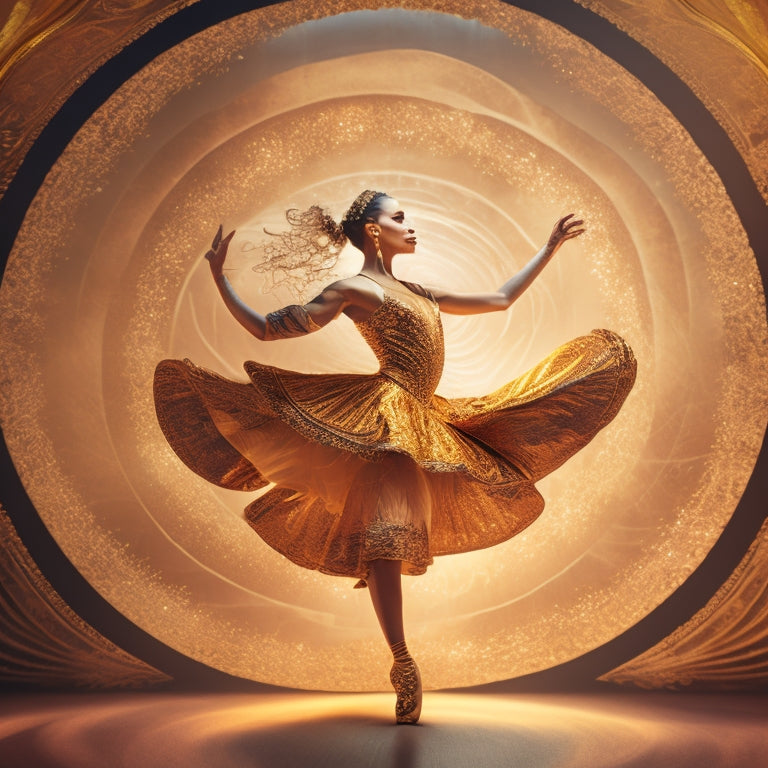
Unlocking the Dance Secrets: Patterns and Choreography
Share
Mastering patterns and choreography is crucial in revealing the full expressive potential of ballroom and Latin dance. By recognizing and refining dance structures, alignments, and sequences, dancers can convey emotion, tell stories, and connect with their audience on a deeper level. Effective practice strategies, such as breaking down complex patterns, and choreography techniques like varying tempo and dynamics, elevate artistic interpretation. As dancers hone their skills, they can tap into their creative expression, experimenting with innovative movements and improvisational techniques. As we explore the intricacies of patterns and choreography, the secrets of dance begin to reveal themselves, unveiling new possibilities for expression and connection.
Key Takeaways
• Mastering patterns and choreography is essential to unlock a dancer's full expressive potential and elevate artistic interpretation.
• Developing pattern recognition skills helps understand dance structure, shifts, and alignment, leading to refined technique and expression.
• Breaking down complex patterns into manageable components is an effective practice strategy for mastering choreography.
• Varying tempo and dynamics in choreography techniques can add depth and emotion to a dance performance.
• Regular rehearsals and technique refinement are crucial to mastering patterns and choreography, leading to compelling performances.
Ballroom and Latin Dance Fundamentals
Among the diverse array of dance styles, ballroom and Latin dance stand out for their timeless elegance and enchanting rhythms, with each style boasting its unique characteristics, techniques, and expressive qualities.
In ballroom dance, the Waltz, Foxtrot, Tango, Quickstep, and Viennese Waltz are characterized by specific basic steps and advanced sequences. The Waltz, for instance, features smooth movements with a box-like pattern, while the Foxtrot is marked by continuous movements with a slow-slow-quick-quick rhythm.
Similarly, Latin dance styles like Salsa, Cha-Cha, Rumba, Samba, and Jive are defined by their lively rhythms and distinctive figures. Mastering the basic steps and advanced sequences of these styles is essential for dancers seeking to refine their skills and expression.
Mastering Patterns and Choreography
In the domain of ballroom and Latin dance, mastering patterns and choreography is the key to revealing a dancer's full expressive potential. It enables them to weave together intricate sequences and tell compelling stories through movement.
To achieve mastery, dancers must develop their pattern recognition skills, understanding dance structure, shifts, and alignment. Effective practice strategies involve breaking down complex patterns into manageable components, rehearsing regularly, and refining technique through repetition.
Choreography techniques, such as varying tempo and dynamics, can elevate a dancer's artistic interpretation, conveying emotion and connection with the audience. By honing these skills, dancers can tap into their creative potential, crafting enthralling performances that leave a lasting impression.
Unleashing Creative Expression
By embracing the nuances of pattern recognition and choreography, dancers can open the doors to creative expression, freeing themselves to craft distinctive and enthralling performances that resonate deeply with the audience.
Through creative exploration, dancers can experiment with innovative movements, transcending traditional boundaries and revealing a world of artistic possibilities.
Improvisational techniques, such as freestyle movements and spontaneous reactions, allow dancers to tap into their inner selves, unleashing a raw, emotional authenticity that captivates the audience.
As dancers explore new modes of expression, they develop a unique voice, weaving a narrative that is both personal and universal.
This creative expression not only elevates their performances but also fosters a deeper connection with the audience, leaving a lasting impression.
Frequently Asked Questions
What Is the Best Way to Practice Dance Patterns at Home?
To master dance patterns at home, set up a practice space with a mirror, create a schedule, and dedicate time to rehearse, focusing on technique and muscle memory, ensuring a strong foundation for confident performance.
Can I Learn Dance Choreography Without Prior Experience?
While novice dancers may think choreography is reserved for the experienced, the truth is, anyone can learn dance choreography without prior experience by mastering dance fundamentals and employing effective learning strategies, such as breaking down patterns and practicing intentionally.
How Do I Overcome Performance Anxiety Before a Dance Competition?
To overcome performance anxiety before a dance competition, practice calming breathing exercises, such as diaphragmatic breathing, and mentally reframe your mindset by focusing on the joy of performing, rather than fear of judgment, to boost confidence and poise.
What Is the Ideal Frequency for Dance Lessons to Achieve Progress?
Coincidentally, a well-structured dance schedule is crucial to progress. To achieve maximum growth, aim for 2-3 dance lessons per week, ensuring practice consistency and allowing your body to adapt to new techniques, ultimately refining your skills.
Can I Customize a Dance Routine for a Special Occasion or Event?
"Absolutely! Our expert instructors can craft a customized dance routine tailored to your special occasion or event, incorporating Personalized Steps to create Memorable Moments that will leave a lasting impression on you and your guests."
Related Posts
-

Why Digital Solutions Are a Game-Changer
By integrating digital solutions into your operations, you can revolutionize your workflows, discover new revenue str...
-

Get Moving: Dance Charades Cards Energize Fun
Dance Charades Cards are the ultimate party sparkplug, igniting a fun-filled frenzy of energetic excitement, funky mo...
-

Elder Hall Hosts Bird Dance Extravaganza
On March 1, 2024, Elder Hall will come alive with the 'Dancing with the Birds' event, a mesmerizing fusion of music, ...


